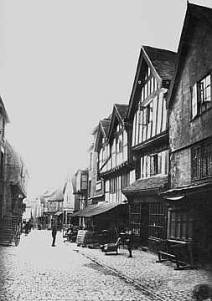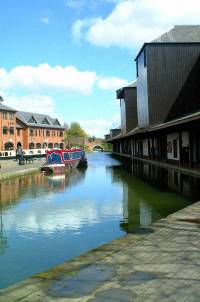 The town of Coventry, where Mary was born, has several claims to fame,
including Lady Godiva, and the British silk industry of the 18th and
19th centuries. This artwork on the Lady Godiva procession, by Thomas
Stevens, was woven in silk, thus linking these two aspects of Coventry
history.
The town of Coventry, where Mary was born, has several claims to fame,
including Lady Godiva, and the British silk industry of the 18th and
19th centuries. This artwork on the Lady Godiva procession, by Thomas
Stevens, was woven in silk, thus linking these two aspects of Coventry
history. Mary Greenaway (1818-c1853)
This block will be replaced by LeftMenuGaffey (orByrnes) when the page is served from a server.
- Father:
- Charles Greenway (1794-1845)
- Mother:
- Mary
Gould (1792-1876)
- Birth/Baptism:
- Nov 12, 1818, Holy Trinity, Coventry[1]
- Marriage:
- Samuel Archer, 5 December 1841, Walmer, Kent[2]
- Children:
- Emma Archer (1842-1911) married Felice Pobar, 1858, Strathfillan (Vic.)
- [John] Arthur ARCHER (1848 - 1931
- Frederick Samuel ARCHER (1850 - 1931)

Mary was born into a working class artisan family in Coventry in the English midlands –generations before her worked in the silk trade of Coventry, as ribbon weavers[3], while some records give emphasis to the watch making trade. Mary’s grandfather James Greenaway is recorded in an index of master weavers in 1797, when his eldest son James, Mary’s uncle, was apprenticed to him[4]. Mary's father Charles Bird Greenway is variously recorded as a watchmaker and then a weaver - so his change of occupation is a bit of a puzzle, although the inclusion of Charles middle family name makes it almost certain we are dealing with the same main.
The tradition of the
Greenway/Greenaway family of incorporating the wife’s maiden name as the
middle name of subsequent children is considered a good clue as to which
children belong to which family, as the surname is a common one
among the silk trade workers in Coventry.
Mary’s parents had married in 1815, at Chilvers Coton, an area now integrated into the Coventry suburb of Nuneaton. In later years in Australia, Mary’s family always listed her name as “Mary Gold Greenaway” – the middle name probably a clerical corruption of “Gould”, her mother’s maiden name. Mary was one of ten children born to Charles Bird Greenway and Mary Gould, while Charles himself was one of eight born to the master weaver James Greenway and his wife, Mary Bird.
Mary’s parents had married in 1815, at Chilvers Coton, an area now integrated into the Coventry suburb of Nuneaton. In later years in Australia, Mary’s family always listed her name as “Mary Gold Greenaway” – the middle name probably a clerical corruption of “Gould”, her mother’s maiden name. Mary was one of ten children born to Charles Bird Greenway and Mary Gould, while Charles himself was one of eight born to the master weaver James Greenway and his wife, Mary Bird.
The surviving
documentation in which Mary is mentioned are her baptism at Holy Trinity
church in Coventry, the 1841 UK Census, where she is described as
a 'weaver' as is her father, her mother and her sister Sarah, her
children's birth, marriage and death certificates, and her husband’s
death certificate. Her husband Samuel also came from a Warwickshire
family, in his case, though, not from the silk industry. Samuel, like
his father, was an Army man, and at the time of his marriage to Mary,
was a sergeant in the 12th (Infantry) Regiment.
So far, Mary's own death certificate has not been found, but she died in the 1850s in Mauritius, when Samuel was stationed there with his regiment, as she did not accompany him and their surviving children when they made a new life in Australia. Her youngest son Frederick, who was born in Mauritius in 1849, says after his mother's death when he was eight, his father took him, his brother John (known by his second name Arthur) and sister Emma to Australia. Frederick's time scale is a little out here - Those dates would put Mary's death in 1857, by which time Samuel and the children had been in Australia for a year. However. presumably Mary died only a very short time before her family set sail to Australia, in 1856.
As well as those three children, Mary and Samuel had three others, two boys and a girl, who died in childhood.[5]
(Back in Warwickshire, as Mary was starting her years in Mauritius, her father, Charles Bird Greenway had succumbed to a particularly virulent bronchitis attack, and died at the comparatively young age of 51. At the time of his death in 1845, Charles and his wife were living in Much Park Street, Coventry. After Charles’ death, his widow continued to work in the silk industry, but by 1851, she was living in Union Street with her daughter Sarah, son John, and two grandchildren.[6])

A Coventry street, Butchers’ Row, as it was in the 19th century

and (in 2002), a canal in the old area of Coventry
[1] IGI, Batch no 041921
[2] England,Marriages, 1538-1973, Salt Lake City, Utah, FamilySearch, 2013, FHL Film Number, 1866577, Ref ID: item 4 p 136. ( This record was located for me by an English researcher, Judith Le Sage)
[3] 1851 Census of Warwickshire, and the death certificate of Charles Greenway
[4] Joan Lane (ed), Coventry Apprentices and their Masters 1781-1806, Dugdale Society, Shakespeare Centre, Stratford upon-Avon, Warwickshire, 1983, p46.
[5] Samuel Archer’s death certificate
[6] UK 1851; PRO REF HO/107/2067; Folio 358, Page 10, FHL Film 0087330.